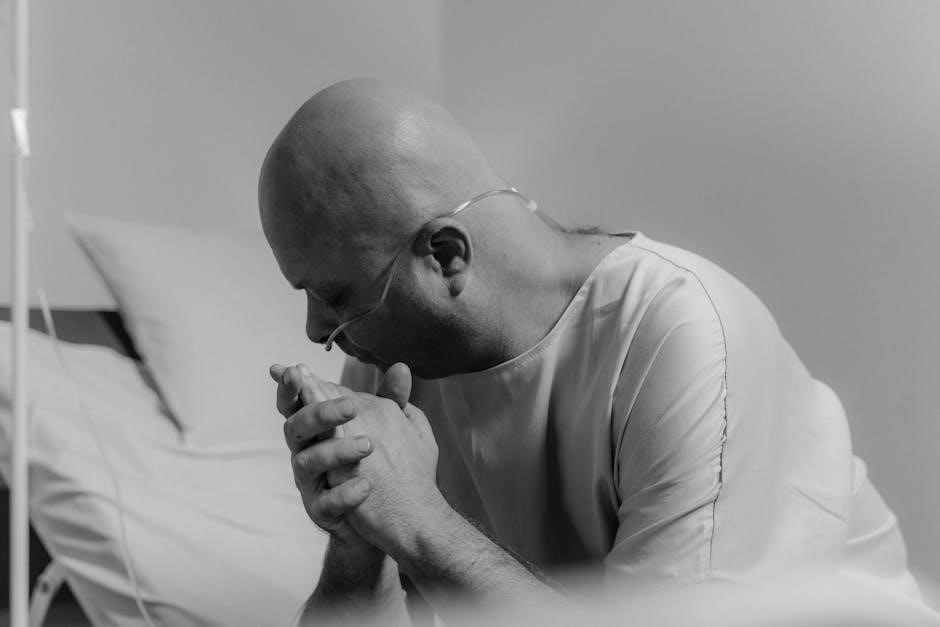Proper assembly of an Invacare hospital bed is crucial for ensuring safety, functionality, and patient comfort․ This guide provides step-by-step instructions for caregivers and technicians․
1․1 Understanding the Importance of Proper Assembly
Proper assembly of an Invacare hospital bed is critical to ensure patient safety, functionality, and comfort․ Incorrect assembly can lead to structural instability, electrical malfunctions, or improper alignment of components like side rails and mattress supports․ This can result in injuries to patients or caregivers and may void the product warranty․ Following the manufacturer’s instructions ensures that all features, such as height adjustability and mobility, function correctly․ Proper assembly also guarantees compliance with safety standards, providing a reliable and durable solution for healthcare environments․ This guide offers a clear, step-by-step approach based on Invacare’s official manuals․
1․2 Overview of Invacare Hospital Beds
Invacare hospital beds are designed for versatility and reliability, catering to both clinical and homecare settings․ They offer features like electric adjustment, manual controls, and interchangeable components, ensuring flexibility for various patient needs․ These beds are built with durable materials and ergonomic designs to enhance patient comfort and caregiver efficiency․ Models such as the Medley Ergo and G-Series provide advanced functionality, including adjustable height, tilt, and side rail systems for safety․ Invacare beds are trusted globally for their quality and innovation, making them a preferred choice in healthcare environments․ This guide focuses on assembling these models effectively․

Planning and Preparation
Before assembling an Invacare hospital bed, gather all tools, ensure a clean workspace, and review the manual to avoid errors and ensure safety․
2․1 Tools and Equipment Needed
To assemble an Invacare hospital bed, you will need essential tools such as a socket wrench, Allen key, screwdrivers, and a measuring tape․ Ensure all components are unpacked and organized․_lock the caster to prevent movement during assembly․ Having a clean, flat workspace is crucial for efficiency and safety․ Refer to the user manual for specific tools required for electrical components․ Proper preparation prevents delays and ensures a smooth assembly process․ Always double-check the completeness of the tool kit before starting․
2․2 Safety Precautions and Tips
Always read the user manual thoroughly before starting the assembly․ Wear protective gear like gloves and safety glasses to avoid injuries․ Ensure the workspace is clear of clutter and tripping hazards․ Lock the bed’s casters during assembly to prevent accidental movement․ Avoid over-tightening bolts, as this may damage components․ Keep children and pets away from the assembly area․ If unsure about any step, consult the manual or contact a professional․ Double-check each step for stability and safety before finalizing․ Proper precautions ensure a secure and functional bed for patient use․
2․3 Preparing the Workspace
Choose a spacious, flat, and stable area for assembly․ Ensure the floor is clear of obstacles to allow easy movement and prevent accidents․ Cover the floor with a protective cloth to avoid damage from tools or bed parts․ Organize tools and components in labeled containers for quick access․ Position the bed frame and mattress support platform in the center of the workspace․ Ensure all electrical components are kept away from water and moisture․ Open the user manual and have it within easy reach for reference․ A well-prepared workspace ensures efficient and stress-free assembly of the Invacare hospital bed․
Unpacking and Inspection
Carefully unpack all components from the boxes, checking for damage or missing parts․ Verify the integrity of each item against the provided inventory list․
3․1 Carefully Unpacking All Components
Begin by carefully opening each box and removing the contents․ Handle fragile parts with care to avoid damage; Use a soft cloth or gloves to protect components․ Ensure all items are accounted for by cross-referencing with the inventory list․ Inspect each part for scratches, dents, or other damage․ If any damage is found, contact Invacare support immediately․ Proper unpacking ensures a smooth assembly process and prevents delays․ Organize the components in a clean, dry workspace to maintain efficiency and safety during assembly․ This step is critical for a successful setup․
3․2 Checking for Damage or Missing Parts
After unpacking, meticulously inspect each component for visible damage, such as dents, scratches, or broken pieces․ Verify that all parts listed in the inventory are present․ Missing or damaged items can delay assembly and compromise safety․ If any issues are found, contact Invacare customer support immediately․ Proper inspection ensures that assembly proceeds smoothly and safely․ This step is critical for identifying potential problems early, preventing complications during the setup process․ Always prioritize thorough checking to guarantee all components are in perfect condition․
Assembling the Bed Frame
Begin by attaching the universal bed ends to the frame, ensuring secure alignment․ Use bolts and nuts to tighten all connections firmly for stability and safety․
4․1 Attaching the Universal Bed Ends
To attach the universal bed ends, align them with the bed frame brackets, ensuring proper fitment․ Secure each end using the provided bolts and washers․ Tighten firmly but avoid overtightening․ For stability, ensure the ends are evenly spaced and aligned․ Invacare recommends this step be performed by two people for safety․ Once attached, double-check the connections to prevent any shifting during use․ Proper alignment is critical to ensure the bed functions correctly and safely․ Always refer to the manufacturer’s manual for specific torque specifications and safety guidelines․ Improper assembly may lead to instability or structural issues․
4․2 Securing the Frame with Bolts and Nuts
After attaching the universal bed ends, secure the bed frame using the provided bolts and nuts․ Tighten all connections evenly to ensure stability․ Use a torque wrench to apply the recommended tension, as specified in the manual․ Avoid overtightening to prevent damage to the frame․ Once all bolts are secured, inspect the frame for any loose connections․ Properly tightened bolts ensure the bed remains stable during use․ Always follow Invacare’s guidelines to maintain structural integrity and safety․ Secure connections are vital for patient safety and optimal bed performance․ Double-check all fasteners before proceeding to the next step․
4․3 Ensuring Stability and Leveling
After securing the frame, ensure the bed is stable and level․ Use the caster locks to prevent movement during assembly․ Check the bed’s legs and adjust them as needed to achieve even balance․ A spirit level can be used to verify proper alignment․ Ensure the bed frame is level both lengthwise and widthwise․ If the bed is uneven, adjust the leg extensions or shims provided in the kit․ Proper leveling ensures smooth operation of the bed’s features and prevents accidental tipping․ Always refer to the Invacare manual for specific leveling instructions to guarantee safety and optimal performance․
Installing the Mattress Support Platform
The mattress support platform is essential for comfort and functionality․ Secure it tightly to the bed frame using the provided hardware․ Ensure proper alignment and stability․
5․1 Placing the Platform on the Frame
To ensure a proper fit, align the mattress support platform with the bed frame’s pre-drilled holes․ Gently lower it into position, making sure it sits evenly; Secure it using the bolts provided in the assembly kit․ Tighten firmly but avoid over-tightening, which could damage the platform․ Once in place, double-check that the platform is level and stable․ Proper alignment is crucial for the bed’s functionality and patient safety․ Always follow the manufacturer’s guidelines for correct placement and securing methods to avoid any issues during use․
5․2 Adjusting the Grub Screws for Proper Fitting
After placing the mattress support platform, locate the grub screws on the bed frame․ Turn them clockwise or counterclockwise to adjust the angle between the platform and the frame․ Ensure the platform fits snugly without gaps․ Proper alignment ensures the side rails function correctly․ Tighten the screws firmly once the desired fit is achieved․ Refer to the user manual for specific torque recommendations․ This step is critical for the bed’s stability and safety, preventing any movement or misalignment during use․ Always test the bed after adjustments to confirm everything is secure․

Attaching the Side Rails
Mount the side rails to the bed frame, ensuring the release system aligns properly․ Secure them with the provided bolts and test their functionality․ Always follow manual instructions․
6․1 Mounting the Side Rails to the Bed Frame
To mount the side rails, align the fork links with the bed frame’s mounting points․ Secure them using the provided bolts, ensuring proper alignment․ Tighten firmly but avoid over-tightening․ Place the side rails at the head and foot ends, matching the release system to the frame․ Double-check the alignment to ensure smooth operation․ Lock the caster locks to prevent bed movement during assembly․ Follow the manual’s specific torque specifications for bolts․ Once mounted, test the side rails by lifting and lowering to ensure they function correctly․ Proper installation is critical for patient safety and bed stability․ Always refer to the Invacare manual for detailed guidance․
6․2 Ensuring Proper Function of the Release System
After mounting the side rails, test the release system to ensure it operates smoothly․ The release mechanism should engage and disengage effortlessly, allowing the rails to move up and down without resistance․ Check that the spring buttons or levers function correctly, securing the rails in both raised and lowered positions․ Lubricate moving parts if necessary to maintain smooth operation․ Ensure the release system aligns properly with the bed frame to prevent misalignment, which could hinder functionality․ Testing the release system thoroughly ensures patient safety and ease of use for caregivers․ Refer to the Invacare manual for specific instructions on adjustments․

Configuring the Bed’s Electrical Components
This section covers the installation and setup of the bed’s motor, control unit, and wiring․ Follow Invacare’s guidelines for safe and proper electrical connections․
7․1 Installing the Motor and Control Unit
Begin by attaching the motor to the bed frame using the provided mounting brackets and screws․ Ensure the motor is securely fastened to avoid any movement during operation․
Next, connect the control unit to the motor, following the wiring diagram in the manual․ Double-check all connections for tightness and proper alignment․
Finally, test the motor and control unit to ensure smooth operation of the bed’s adjustable features․ Refer to the Invacare manual for specific torque and alignment specifications․
7․2 Connecting the Wiring and Caster Locks
Connect the wiring harness to the motor and control unit, ensuring all plugs are securely seated and properly aligned․ Refer to the wiring diagram in the manual for correct connections․
Once connected, test the electrical components to confirm proper functionality․ Tighten any loose connections to prevent malfunctions during use․
Finally, engage the caster locks to stabilize the bed and prevent unintended movement․ Ensure all wheels are locked before testing the bed’s adjustability features․
7․3 Testing the Electrical Functions
After connecting the wiring and caster locks, test all electrical functions to ensure proper operation․ Use the control panel to adjust the bed’s height, tilt, and side rails, verifying smooth movement and responsiveness․
Check that all buttons and controls function correctly, and ensure there are no unexpected sounds or jerky motions․ Inspect the wiring connections for any signs of looseness or damage․
If any issues arise, refer to the troubleshooting section or contact Invacare support․ Once all functions are confirmed to be working, lock the casters to secure the bed in place for patient safety․
Final Adjustments and Customization
Adjust the bed height and position for optimal patient comfort․ Customize features like side rail settings and mattress positioning to meet individual needs․ Ensure all adjustments are secure․
8․1 Adjusting the Bed Height and Position
To adjust the bed height, use the hand crank or electric controls, depending on the model․ Lower or raise the bed to a comfortable level for the patient․ Ensure the bed is stable and even․ For positioning, adjust the head and foot sections as needed for patient comfort․ Use the side rail adjustments to secure the mattress in place․ Always ensure the mattress is centered on the frame to prevent trapping between the rails and frame․ Test the bed’s mobility by gently pushing it to ensure smooth movement․ Make final checks to ensure all adjustments are secure and functional․ Proper positioning enhances patient safety and comfort․
8․2 Customizing the Bed for Patient Comfort
Customizing the bed involves adjusting features to meet individual patient needs․ Use the hand crank or electric controls to tailor the bed height and position․ Ensure the mattress support platform is securely fitted and adjust the grub screws for proper alignment․ Add optional accessories like bed rails or support brackets for enhanced safety․ For electric models, program the control unit to preset positions for easy adjustment․ Always follow Invacare guidelines for customization to maintain warranty and safety standards․ Test all adjustments to ensure smooth operation and patient comfort․ Proper customization ensures optimal support and ease of use for both patients and caregivers․
Final Inspection and Testing
After assembly, inspect all components for secure connections and proper alignment․ Test bed mobility, electrical functions, and side rail mechanisms to ensure safe and correct operation․
9․1 Ensuring All Parts Are Securely Assembled
After completing the assembly, carefully inspect each part to ensure they are tightly secured․ Check bolts, nuts, and connections for proper tightening․ Verify that side rails, motors, and caster locks are functioning correctly․ Ensure the mattress support platform is level and stable․ Review all components to confirm they are free from damage or misalignment․ This step is critical for preventing malfunctions and ensuring patient safety during use․ Refer to the Invacare manual for specific torque specifications and tightening sequences․
9․2 Testing the Bed’s Mobility and Adjustability
Once assembled, test the bed’s mobility by gently pushing it across the floor to ensure smooth movement․ Check that caster locks engage and disengage properly to secure the bed in place․ Adjust the bed’s height and position to verify seamless operation․ Test the side rails’ raising and lowering mechanisms to ensure they function smoothly․ Additionally, check the electrical components, such as motorized adjustments, to confirm they respond correctly to controls․ Ensure all features work quietly and efficiently․ This step ensures the bed meets safety and functionality standards for patient care․ Always refer to the Invacare manual for specific testing procedures․
Troubleshooting Common Issues
Address issues like loose bolts or faulty electrical connections․ Check for proper wiring and motor function․ If problems persist, consult the Invacare manual or contact support․
10․1 Identifying and Resolving Assembly Errors
Common assembly errors include misaligned parts, loose bolts, or improper wiring․ Inspect all components for damage or misplacement․ Ensure grub screws are tightened correctly for side rail alignment․ If the bed frame wobbles, check stability adjustments․ Verify that the mattress support platform is securely attached․ For electrical issues, review connections and consult the manual․ If problems persist, contact Invacare customer support for assistance․ Proper troubleshooting ensures safety and functionality, preventing potential risks during patient use․
10․2 Addressing Malfunctions in Electrical Components
Electrical issues, such as motor failure or wiring problems, require immediate attention․ First, check all connections to ensure they are secure and properly plugged in․ Verify that the control unit is functioning correctly and that no wires are damaged․ If the bed’s adjustability features malfunction, consult the user manual or contact Invacare support for troubleshooting guidance․ In case of persistent issues, authorized technicians should perform repairs to maintain safety and compliance․ Regular maintenance can help prevent electrical malfunctions and ensure smooth operation․

Maintenance and Upkeep
Regular cleaning and inspections are essential to maintain the bed’s functionality and patient safety․ Follow Invacare’s guidelines for sanitizing and checking for wear and tear․
11․1 Cleaning and Sanitizing the Bed
Regular cleaning and sanitizing are essential to maintain hygiene and prevent the spread of infections․ Use a mild detergent and warm water to wipe down all surfaces, paying attention to high-touch areas like side rails and controls․ Avoid harsh chemicals or abrasive cleaners, as they may damage the bed’s finish․ Sanitize using a solution of 70% isopropyl alcohol or a hospital-grade disinfectant․ Ensure the bed is dry before use to prevent water spots or bacterial growth․ Follow Invacare’s guidelines for specific materials and electrical components to maintain warranty and safety standards․
11․2 Regular Checks for Wear and Tear
Regular inspections are vital to identify and address wear and tear on the Invacare hospital bed․ Check all bolts and nuts for tightness, especially after initial assembly․ Inspect caster wheels for damage or debris accumulation, which could affect mobility․ Examine side rails for proper alignment and functionality, ensuring the release system operates smoothly․ Look for cracks or dents in the bed frame and mattress platform․ Test electrical components, such as motors and control panels, for any malfunctions․ Addressing these issues promptly helps maintain patient safety and extends the bed’s lifespan․
Optional Enhancements
Enhance the bed’s functionality by adding accessories like bed rails, support platforms, or storage options․ Install safety features such as anti-entrapment kits or alarms for improved patient security․
12․1 Adding Bed Accessories for Comfort
Enhance patient comfort by adding accessories like cushioned side rails, memory foam toppers, or adjustable headrests․ These additions can improve support and ensure a more restful experience․ Invacare recommends centering the mattress on the bed frame to prevent entrapment risks․ Additionally, consider attaching storage compartments or trays for convenient access to essentials․ Always follow Invacare’s guidelines when installing accessories to maintain safety and warranty compliance․ Properly securing these enhancements ensures the bed remains stable and functional, providing long-term comfort and convenience for patients․
12․2 Installing Additional Safety Features
For enhanced safety, consider adding bed rails, anti-entrapment kits, or sensor alarms; These features help prevent falls and ensure patient security․ Bed rails should be securely attached to the bed frame, following Invacare’s installation guidelines․ Anti-entrapment kits are designed to prevent gaps between the mattress and bed rails, reducing the risk of injury․ Always ensure that safety accessories are compatible with your specific Invacare model and that they are installed correctly to maintain the bed’s stability and functionality․ Regularly inspect these features to ensure they remain in good condition and continue to provide effective protection for patients․
Resources and Support
Access the Invacare user manual, assembly videos, and guides for detailed instructions․ Contact Invacare customer support for assistance with assembly or troubleshooting․ Visit their official website․
13․1 Accessing the Invacare User Manual
The Invacare user manual is a critical resource for assembling and operating the hospital bed․ It provides detailed step-by-step instructions, safety guidelines, and technical specifications․ The manual is available on Invacare’s official website or through authorized distributors․ Ensure you download the correct version corresponding to your bed model․ The manual also includes troubleshooting tips and maintenance recommendations․ Always consult the manual before starting the assembly process to ensure compliance with safety standards and proper installation procedures․ This resource is essential for both caregivers and technicians to guarantee optimal bed functionality and patient safety․
13․2 Finding Assembly Videos and Guides
Invacare provides comprehensive assembly videos and guides to assist with the setup of their hospital beds․ These resources are available on the official Invacare website and YouTube channels like Invacare UK Ltd; Videos offer step-by-step instructions, making complex assembly tasks easier to understand․ Additionally, detailed PDF guides can be downloaded from Invacare’s support section․ These materials cover specific models, such as the Medley Ergo bed, ensuring accurate and model-specific instructions․ For further assistance, users can contact Invacare customer support or refer to authorized distributors for additional resources․
13․3 Contacting Invacare Customer Support
For assistance with Invacare hospital bed assembly, customers can reach out to the dedicated customer support team․ Invacare provides multiple contact options, including phone, email, and live chat, ensuring quick resolution of inquiries․ The official Invacare website lists regional contact details, allowing users to connect with local support specialists․ Additionally, the website features a comprehensive FAQ section and downloadable resources, such as user manuals and troubleshooting guides․ Customers can also submit support tickets online for more complex issues․ Invacare’s customer support is committed to providing timely and effective solutions to ensure smooth assembly and operation of their products․
The Invacare hospital bed assembly is now complete․ Following the detailed steps ensures safety, functionality, and patient comfort․ Customize settings for individual needs and refer to the user manual for further guidance․
14․1 Summary of Key Assembly Steps
Assembly of the Invacare hospital bed involves carefully unpacking and inspecting components, securing the bed frame, attaching bed ends, and installing the mattress platform․ Side rails must be mounted correctly, and electrical components should be connected and tested․ Ensure all bolts and screws are tightened properly, and verify the bed’s stability and leveling․ Adjustments for height and position should be made to suit patient needs․ Finally, test all functions, including mobility and adjustability, to ensure the bed is safe and ready for use․ Refer to the user manual for troubleshooting and maintenance tips․
14․2 Final Tips for Safe and Effective Use
Always prioritize patient safety and comfort by following the manufacturer’s guidelines․ Ensure the bed is properly assembled and tested before use․ Lock the casters to prevent unintended movement and center the mattress to avoid entrapment risks․ Regularly inspect the bed for wear and tear, and address any issues promptly․ Maintain a clean and sanitized environment to prevent infections․ Never exceed the bed’s weight capacity, and ensure caregivers are trained in proper operation․ For any concerns, consult the Invacare user manual or contact their customer support for assistance․



